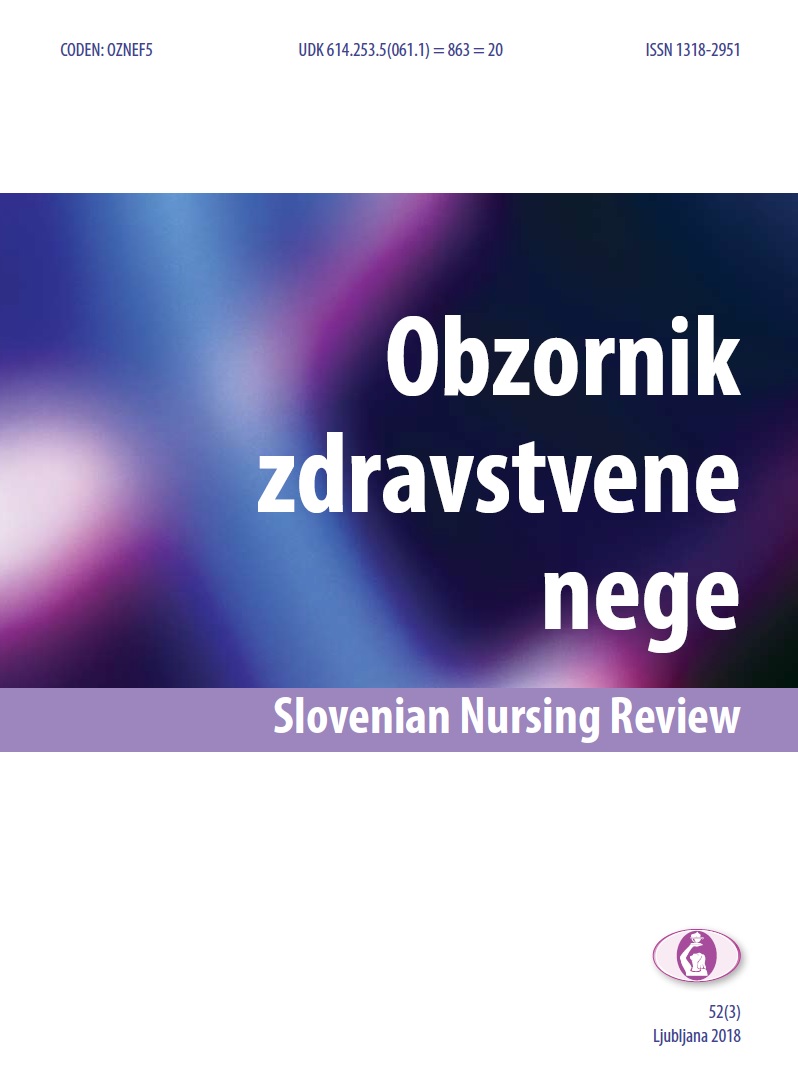A healthy work environment
care for the well-being and health of employees in nursing
DOI:
https://doi.org/10.14528/snr.2018.52.3.851Keywords:
health of employees, nursing, healthy work environmentDownloads
Metrics
References
American Association of Critical-Care Nurses, 2005. AACN standards for establishing and sustaining health work environment. Available at: https://www.aacn.org/WD/HWE/Docs/HWEStandards.pdf [28. 8. 2018].
Boorman, S., 2009. NHS Health and well-being: final report. London: Department of Health. Available at: http://webarchive.nationalarchives.gov.uk/20130103004910/http://www.dh.gov.uk/en/Publicationsandstatistics/Publications/PublicationsPolicyAndGuidance/DH_108799 [28. 8. 2018].
Divinakumar, K.J., Shivram, B.P. & Ram, C.D., 2014. Preceived stress psychological well-being and burnout among female nurses working in governmental hospitals. International Journal of Research in Medical Sciences, 2(4), pp. 1511–1515. https://doi.org/10.5455/2320-6012.ijrms20141150
European Union, 2008. European pact for mental health and well-being: EU high level conference Together for mental health and well-being. Available at: https://ec.europa.eu/health/ph_determinants/life_style/mental/docs/pact_en.pdf [28. 8. 2018].
Evropska komisija, 2010. Evropa 2020: strategija za pametno, trajnostno in vključujočo rast. Available at: http://ec.europa.eu/eu2020/pdf/1_SL_ACT_part1_v1.pdf [28. 8. 2018].
Evropska agencija za varnost in zdravje pri delu, 2018. Okvirna direktiva o varnosti in zdravju pri delu. Available at: https://osha.europa.eu/sl/legislation/directives/the-oshframework-directive/the-osh-framework-directiveintroduction [28. 8. 2018].
Grant, A.M., Christianson, M.K., & Price, R.H., 2007. Happiness, health, or relationship: managerial practices and employee well-being tradeoffs. Academy of Management perspectives, 21(3), pp. 51–63. https://doi.org/10.5465/amp.2007.26421238
Harter, J.K., Schmidt, F.L., & Keyes, C.L.M., 2003. Well-being in the workplace and its relationship to business outcomes: a review of the Galllup studies. In C.I.M. Keyes, & J. Haidt, eds. Flouishing: positive psychology and live well-lived. Washington: American Psychological Association, pp. 205–224. https://doi.org/10.1037/10594-009
Huppert, F.A., 2009. Psychological well-being: evidence regarding its causes and consequences. Applied Psychology: health and well-being, 1(2), pp. 137–164. https://doi.org/10.1111/j.1758-0854.2009.01008.x
International Labour Organization, 2018. Workplace well-being. Available at: https://www.ilo.org/safework/areasofwork/workplace-healthpromotion-and-well-being/WCMS_118396/lang--en/index.htm [28. 8. 2018].
Parks, K.M., & Steelman, L.A., 2008. Organizational wellness programs: a meta-analysis. Journal of Occupational Health Psychology, 13(1), pp. 58–68. https://doi.org/10.1037/1076-8998.13.1.58 PMid:18211169
Purcell, S.R., Kutash, M. & Cobb, S., 2011. The relationship between nurses' stress and nurse staffing factors in a hospital setting. Journal of Nursing Management, 19, pp. 714–720. https://doi.org/10.1111/j.1365-2834.2011.01262.x PMid:21899624
Robertson, I., & Cooper, C., 2011. Well-being: productivity and happiness at work. London: Palgrave Macmillan. https://doi.org/10.1057/9780230306738
Scheick, D.M., 2011. Developing self-aware mindfulness to manage countertransference in the nurse-client relationship: an evaluation and developmental study. Journal of Professional Nursing, 27, pp. 114–123. https://doi.org/10.1016/j.profnurs.2010.10.005 PMid:21420044
Waddell, G., & Burton, K.A., 2006. Is work good for your health and well-being. Available at: https://assets.publishing.service.gov.uk/government/uploads/system/uploads/attachment_data/file/214326/hwwb-is-workgood-for-you.pdf [28.8.2018].
Winwood, P.C., Bakker, A.B., & Winefield, A.H., 2007. An investigation of the role of non-work-time behaviour in buffering the effects of work strain. Journal of Occupational and Environmental Medicine, 49(8), pp. 862–871. https://doi.org/10.1097/JOM.0b013e318124a8dc PMid:17693784
World Health Organization, 2010. WHO healthy workplace framework and model: background and supporting literature and practice. Available at: https://www.who.int/occupational_health/healthy_workplace_framework.pdf [28. 8. 2018].
World Health Organization, 2018. Constitution of WHO: principles. Available at: https://www.who.int/about/mission/en/ [28. 8. 2018].
Wright, T.A., & Cropanzano, R., 2004. The role of psychological well-being in job performance: a fresh look at an age-old quest. Organizational Dynamics, 33(4), pp. 338–351. https://doi.org/10.1016/j.orgdyn.2004.09.002
Downloads
Published
How to Cite
Issue
Section
License
As the author undersigned hereby, I transfer, assign, or otherwise convey the following authorship rights as comprised in the Copyright and Related Rights Act (CRRA) to the Slovenian Nursing Review, Ob železnici 30A, 1000 Ljubljana: the right of reproduction - the exclusive right to fix the work in a material medium or in another copy directly or indirectly, temporarily or permanently, by any means and in any digital form, in whole or in part (CRRA, Article 23); the right of distribution (CRRA, Article 24); the right of making a work available and accessible through the internet (CRRA, Article 32a); the right of transformation, especially the exclusive right to translate a pre-existing work (CRRA, Article 33). The transfer of author rights applies to the article in its entirety, including pictorial and/or graphic works and possible supplements. The transfer of rights is exclusive and unlimited in duration or territory.
























